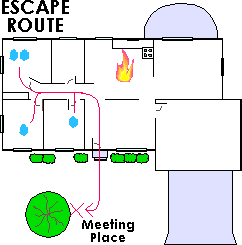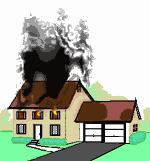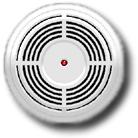|
Home Fire Safety
E.D.I.T.H.
PROGRAM
Exit Drills In The Home, is a nationally recognized program designed to help families survive fires in their homes if they are alerted to the fire and get out quickly!
There are simple and basic things that you and your family can do to act smart and survive a fire.
Fire Safety in the home is everyone's responsibility!!!!
The National Fire Protection Association (NFPA), reported that in 2009, fire departments in the United States responded to an estimated 1,348,500 fires. There were 3,010 civilian deaths, 17,050 injuries due to fire and an estimated direct property loss of $12,531,000,000. With these statistics in mind, this is a good reason why everyone should practice home fire safety. If you have never been the victim of a fire or know some who has, you are very fortunate and hopefully it will stay that way.
Here's how the E.D.I.T.H. Program works:
- Prepare a (birds-eye view) floor plan of your home. Include doors, windows, stairs, porches and porch roofs. Make the drawing large enough to show your meeting place in the yard.
- The plan should show at least two ways to get out of each room. Draw lines from each room, indicating the proper exit direction from each room to the closest exit.
- Sleep with your bedroom door closed. Always have a blanket within easy reach that can be placed at the bottom of the door. Both of these things help to keep smoke and fire out of the room. Make sure that everyone knows how to unlock their rooms window. It can be used as an escape route or even a place to get fresh air. If you can't get out of the room or can't get out of the window, use a shirt, pants or even a blanket to show firefighters where you are.
- Everyone in the home should agree on a fixed location, outside and away from the home, where family members can gather for a head-count. It also makes it easier for firefighters to find you to make sure everyone is out of the home. If someone is missing, let the firefighters know this immediately. DON'T go back in yourself!!! Let the trained firefighters do their job!
- Once you are out of the home, NEVER go back inside for animals, toys or anything you think is important. Your life is more important than any material item you may have in the home. You should call 911 from a cell phone or a neighbors phone. DO NOT use a phone that is inside the house if there is a fire. Though the fire may not be where the phone is, smoke will be and in most cases, people die from smoke inhalation, long before being burned.
- Be Prepared! Make sure everyone in the home knows how to unlock doors and windows. If you have security bars, make sure they are equipped with 'quick release safety latches' and that everyone knows how to use them.
- PRACTICE - PRACTICE - PRACTICE!!!!! Hold a fire drill in your home often and have everyone participate. Speed is vital! Get out quickly and carefully. You may even want to practice using alternative exit routes to simulate a fire blocking your normal exit routes.
- Make sure to test doors for heat before opening them. If they are hot, fire may be on the other side and you don't want to open the door. Use your alternate escape route or at least go to a window so that firefighters can get you out with ladders. If you have a phone in your room, call 911 to let them know exactly where you are.
- While you exit the home, stay low to the floor, on your hands and knees. Smoke and heat rise. By staying low, you can keep below the heat and smoke while getting out.

"HOME FIRE SAFETY CHECKLIST"
This is a checklist that can be used by you and your family to be prepared for a fire. If you answer NO to any of these questions on the checklist, you should fix the problem as soon as possible. Although there is never a guarantee that your home won't catch on fire, using this home fire safety checklist may help to reduce the risk of a fire.
| HOME FIRE SAFETY CHECKLIST |
YES |
NO |
| PRE-FIRE PLANNING |
|
|
| Have you planned at least two ways out of every room in your home? |
|
|
| Do you keep exit routes clear in your home? |
|
|
| Do you know how to call 911 quickly and correctly in case of a fire? |
|
|
| SMOKE AND CARBON MONOXIDE DETECTORS |
|
|
| Are smoke detectors in each bedroom near the door? You should also have a smoke detector on each floor of your home. All new or renovated (50%) homes and buildings are required by law to have smoke detectors on each floor and each bedroom. |
|
|
| Have you tested your smoke detector in the last 6 month's? The fire department also recommends to; "Change Your Clocks, Change Your Batteries". If your smoke detector is more than 10 years old, it's time for a replacement. |
|
|
| Do you have a CO detector in your home? It is recommended to have at least one in every home. |
|
|
| ESPECIALLY FOR CHILDREN |
|
|
| Do you make it a rule never to leave small children alone or unattended? |
|
|
| Do your baby-sitters (and you) know the rule - Get everyone out quickly and stay out! ? |
|
|
| Do you show your baby-sitter the escape routes, meeting place and how to get help (911)? |
|
|
| SMOKING HABITS |
|
|
| Is smoking in bed strictly against the rule in your home? |
|
|
| Do you always make sure the cigarette, cigar or pipe ashes are completely extinguished before you dispose of them? Before going to bed, be SURE there are no cigarettes still burning! |
|
|
| Are matches and lighters kept out of the reach of children? |
|
|
| HEATING AND COOKING |
|
|
| Are furnaces, stoves and chimneys kept in good repair and located far enough away from combustible products so that they do not create a hazard? Use a fireplace screen to prevent sparks from getting onto combustibles. |
|
|
| If you have space heaters, are the properly maintained and located in safe areas? Keep them away from walking paths, curtains and furniture. |
|
|
| Do you have your homes heat source inspected by a professional annually? |
|
|
| Do your sleeves get into things when you cook? Make sure to wear tight-fitting clothing while cooking. |
|
|
| Can you stop a cooking fire safely? Keep a properly fitting lid near while cooking. NEVER use water. If oil starts to smoke, turn down the heat. Do not pour anything into the oil (explosion) |
|
|
| ELECTRICITY |
|
|
| Do you see extension cords are never under rugs or hooked over nails? You should avoid using extension cords whenever possible. NEVER plug one extension cord into another. |
|
|
| When the breaker 'trips' or a fuse 'blows', do you try to find out why? Find the cause! You may be using too much power for the circuit or you may have an issue that requires a professional to inspect. |
|
|
| Are the correct size breakers or fuses used for your electrical system? Don't use pennies as a substitute in fuse boxes. If you are unsure of the correct size, consult a professional. Older homes usually use 15A breakers or fuses while newer homes use 20A breakers. |
|
|
| Is your TV well ventilated? Allow air space around the TV to prevent overheating. |
|
|
| Do you have any cords or extension cords that are showing bare wire? If so, remove them immediately. Not only could someone get shocked or electrocuted, but they may arc and start a fire. |
|
|
| GOOD HOUSEKEEPING |
|
|
| Do you keep rubbish cleaned out of the attic, basement, closets, garage, yard? NEVER store anything within 30" of a furnace or heater. |
|
|
| Are gasoline and other flammable liquids stored in safety cans and kept away from heating sources and children? Do Not store gasoline or other flammable liquids in your home! Keep them in an outside storage area. Don't fill a hot lawn mower; let it cool down first. |
|
|
To make a copy of this "Home Fire Safety Checklist", go to the top of the list and place your cursor just before the 'H' for 'Home'. Hold down the 'left' mouse button and drag it to the right of the page, then down to the very bottom of the list, thus highlighting all words and blocks of the checklist. Release the 'left' mouse button and your selection should remain highlighted. Move your cursor over the highlighted area and click the 'right' mouse button. A box will appear with options inside. Move your cursor to the 'Print...' and click the 'left' mouse button. A new "PRINT" window should appear with printer options. Go to the option area "Print Range" and click the 'left' mouse button on 'Selection'. Then, click the 'left' mouse button over the "PRINT" tab and your printer will print the checklist. If you are having problems printing this checklist, send an email to co8@ubfc8.org and we will email you a printable copy of the checklist.
ASK YOURSELF THESE QUESTIONS
If your home caught on fire, what would you do?
What would your children do?
Does everyone know where to go?
Do they know how to call for help?
IF A FIRE SHOULD OCCUR IN YOUR HOME.........
- GET OUT OF THE HOUSE. Each family member should familiarize themselves with at least two exits from each room; for example - one door and one window. Know where every exit from the home is and practice using them.
- HAVE A MEETING PLACE LOCATED OUTSIDE THE HOME. When a fire happens, it is not the time to worry about who made it out and who didn't. By establishing a meeting place before a fire happens, you can do a head-count and not have to wonder who might still be inside. If you are missing someone, let the fire department know immediately. DO NOT go back into the house. This is a job for trained firefighters who have protective gear.
- CALL 911 FROM A CELL PHONE OR A NEIGHBORS HOUSE. DO NOT use the phone from your house unless you are trapped. If you are trapped, call 911 and let the operator know what is happening and where you are inside of the house. DO NOT hide under clothing, blankets, beds or in closets. Go to a window and open it just a little. Stick something out the window to alert firefighters.
- NEVER GO BACK INTO A BURNING HOUSE FOR ANY REASON. Once you are outside, STAY OUT!!! Go to your meeting place and wait for the fire department. They will be there within minutes of a 911 call.
IN A FIRE, SECONDS COUNT
For early detection of fires, make sure you have working smoke detectors in the recommended locations listed above. It is a proven fact, that smoke detectors save lives. Make sure to test your smoke detectors at least every six month's and that you "Change Your Clocks, Change Your Batteries". You should also clean the dust out of them when you change your batteries. Smoke detectors are sensitive to dust and may alert if not kept clean. If the smoke detector "chirps" or "beeps", check for fire first. If no fire is found or you don't smell smoke, the batteries may be dead, the unit may have dust in it or the smoke detector has reached it life expectancy. If your smoke detector(s) are more than 10 years old, it is recommended that you replace them. above. It is a proven fact, that smoke detectors save lives. Make sure to test your smoke detectors at least every six month's and that you "Change Your Clocks, Change Your Batteries". You should also clean the dust out of them when you change your batteries. Smoke detectors are sensitive to dust and may alert if not kept clean. If the smoke detector "chirps" or "beeps", check for fire first. If no fire is found or you don't smell smoke, the batteries may be dead, the unit may have dust in it or the smoke detector has reached it life expectancy. If your smoke detector(s) are more than 10 years old, it is recommended that you replace them.
Batteries for 6 smoke detectors cost less than $10 and a new smoke detector costs less than $20.
WHAT ARE YOUR FAMILIES LIVES WORTH TO YOU???
- Develop a 'Home Fire Escape Plan" and practice using it.
- Establish EDITH drills regularly for everyone in your home.
- Consider purchasing 'Escape Ladders' or ropes for second floor bedrooms if you don't have a roof to climb
 onto. onto.
- Check windows that might be used for escape and insure that they unlock and open easily for everyone.
- Remember to crawl if there is smoke. Cooler and cleaner air will be closer to the floor.
- If your clothing catches on fire, it will burn quickly. DO NOT RUN!... STOP,DROP and ROLL!!!! Make sure to cover your face with your hands. This may prevent your face from being burned.
REMEMBER THAT THE BEST STEP TO HOME FIRE SAFETY IS TO PREVENT A FIRE FROM HAPPENING IN THE FIRST PLACE
Knowing what to do if a fire occurs is very important. Even more important still, is the prevention of a fire in the first place. Take the time to inspect your home for safety and fire hazards. Use the checklist above and include your family in searching for safety and fire hazards. Everyone in the home is responsible for fire safety. By checking for possible hazards, you may prevent a major tragedy and save the lives of your family.
If you would like assistance with designing a home escape plan, proper placement of smoke detectors/CO detectors or you would like tips on how to complete a "Home Fire Safety Checklist", contact us at co8@ubfc8.org or call the fire station at (410)775-7422.
If you don't live in the area covered by the Union Bridge Fire Company, contact your local fire department and ask if they can assist you.
|

